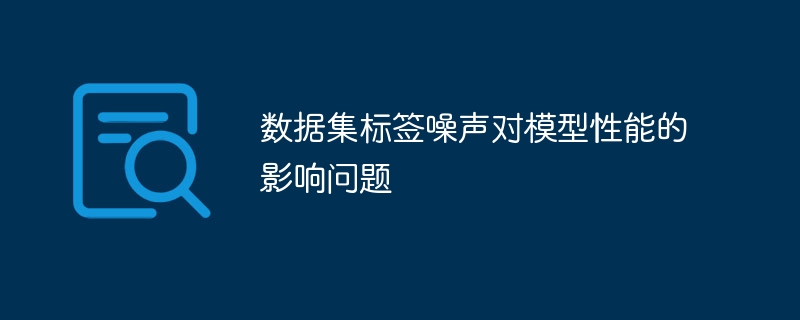
The impact of data set label noise on model performance and code examples
Abstract: In the field of machine learning, the quality of the data set is crucial to the performance of the model Impact. Among them, label noise refers to the presence of wrong or inaccurate labels in the data set. This article will explore the impact of dataset label noise on model performance and provide code examples to demonstrate how to handle and correct the negative impact of label noise on model performance.
- Introduction
In machine learning, a common assumption is that the labels of the data set are accurate. However, in the real world, in many cases we cannot guarantee that the labels in the dataset are completely accurate. Label noise can be introduced during data collection, annotation, or manual prediction. If there is a large amount of label noise in the data set, the performance of the model will be greatly affected. Therefore, it is of great significance to study how to deal with and correct the negative impact of label noise on model performance.
- The impact of data set label noise
Label noise in the data set can cause the following problems during model training:
(1) Wrong labels will affect the model’s correct classification of input samples, thus Reduce the accuracy of the model.
(2) Label noise may introduce the over-fitting problem of the model, causing the model to perform well on the training set, but perform poorly on unseen data.
(3) Incorrectly labeled samples may interfere with the optimization process, causing the model to have difficulty converging or even failing to converge.
- Label noise processing method
In order to process and correct label noise, there are several commonly used methods that can be used:
(1) Manual correction: Correct label noise through experts or manual operations. However, the disadvantage of this method is that it is time-consuming, labor-intensive, and often impractical on large-scale data sets.
(2) Label smoothing: Reduce the impact of label noise by smoothing labels. Commonly used label smoothing methods include label smoothing and core label smoothing.
(3) Iterative learning: Reduce the impact of label noise through multiple iterative learning processes. In each iteration, misclassified samples are relabeled and the model is retrained.
- Code Example
The following will provide a specific code example to demonstrate how to handle and correct the negative impact of label noise on model performance. Suppose we have a binary classification data set, and there is a certain proportion of label noise in the data set.
import numpy as np
import pandas as pd
from sklearn.model_selection import train_test_split
from sklearn.linear_model import LogisticRegression
# 加载数据集
data = pd.read_csv("data.csv")
# 分离特征和标签
X = data.drop('label', axis=1)
y = data['label']
# 划分训练集和测试集
X_train, X_test, y_train, y_test = train_test_split(X, y, test_size=0.2)
# 创建模型
model = LogisticRegression()
# 模型训练
model.fit(X_train, y_train)
# 模型评估
accuracy = model.score(X_test, y_test)
print("模型准确率:", accuracy)Copy after login
In the above code, we use the logistic regression model to train the data set and evaluate the accuracy of the model. However, due to the presence of label noise in the dataset, the performance of the model may not be ideal. In order to reduce the impact of label noise on model performance, we can try to use the above-mentioned processing methods for data preprocessing or model training process.
- Conclusion
Dataset label noise has an important impact on model performance. This article explores the impact of label noise on model performance and provides code examples for handling and correcting label noise. In practical applications, we need to choose appropriate methods to deal with label noise according to specific situations to improve the performance and accuracy of the model.
References:
- Patrini, G., Rozza, A., Menon, A. K., Nock, R., & Qu, L. (2017). Making deep neural networks robust to label noise: A loss correction approach. Neural Networks, 99, 207-215.
- Reed, S. E., Lee, H., Anguelov, D., Szegedy, C., Erhan, D ., & Rabinovich, A. (2014). Training deep neural networks on noisy labels with bootstrapping. arXiv:1412.6596.
- Hendrycks, D., Mazeika, M., Cubuk, E. D., Zoph, B., Le, Q. V., & Wilson, D. (2018). Using self-supervised learning can improve model robustness and uncertainty. arXiv:1906.12340.
The above is the detailed content of The impact of data set label noise on model performance. For more information, please follow other related articles on the PHP Chinese website!






